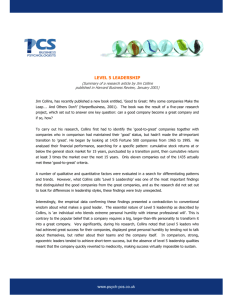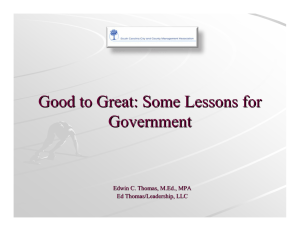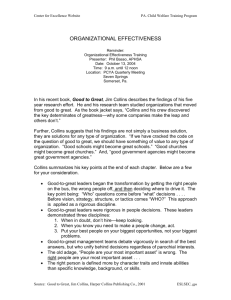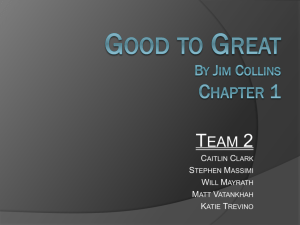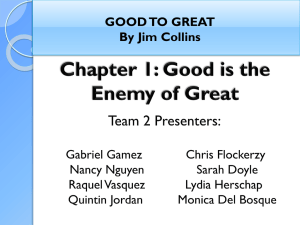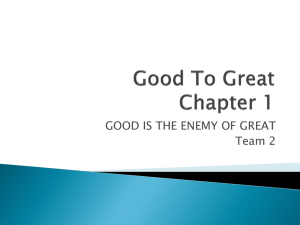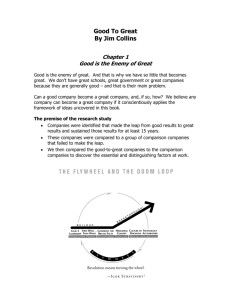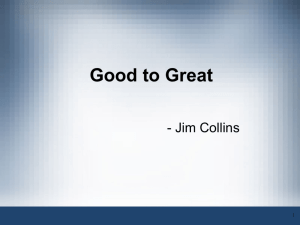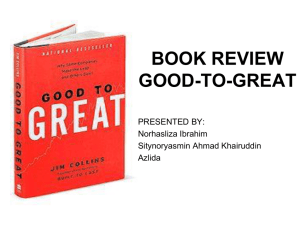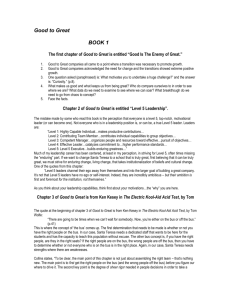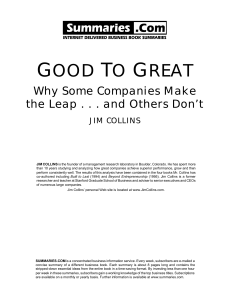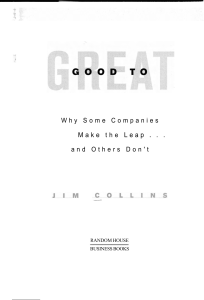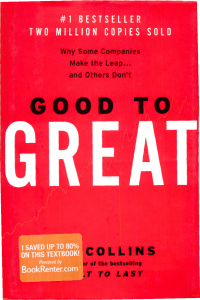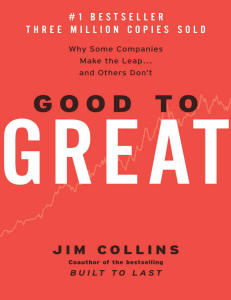GOOD TO GREAT By: Jim Collins
advertisement
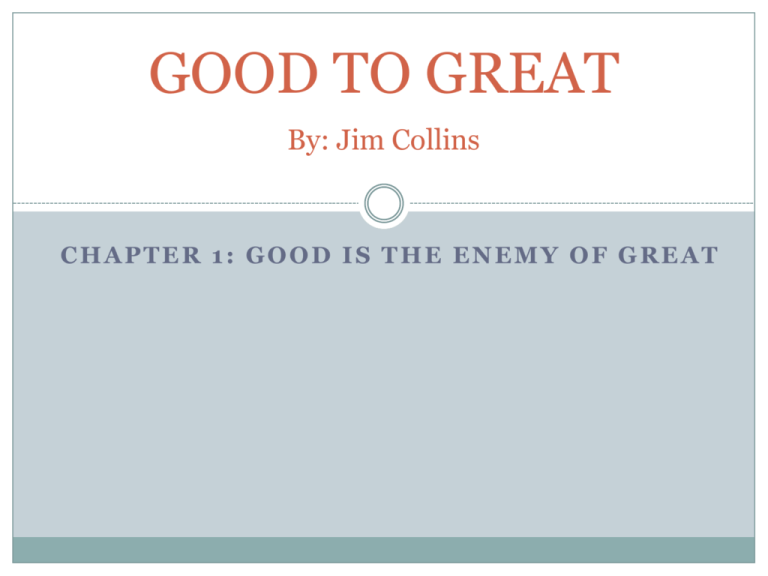
GOOD TO GREAT By: Jim Collins CHAPTER 1: GOOD IS THE ENEMY OF GREAT GOOD IS THE ENEMY OF GREAT “The vast majority of companies never become great, precisely because the vast majority become quite good-and that is their main problem.” (p. 1) So, what does it take for a company to go from a good company to a great company? A Little Research Background Collins and his 21 man research team conducted a study to find what companies went from good to great and how exactly they did just that. It took them about 5 years Why did Collins take on this study? CURIOSITY A Little More Research Background Total project (The Black Box): Consumed 10.5 people years of effort Read and systematically coded nearly 6,000 articles (below) Generated more than 2,000 pages of interview transcripts Created 384 million bytes of computer data “Coding Document” Examples Coding Category 1-Organizing Arrangements Coding Category 2-Social Factors Coding Category 3-Business Strategy TOTAL OF 11 CODING CATEGORIES FROM THE FOUNDING OF THE COMPANY TO PRESENT DAY. Think of it as… “If you invested $1 in a mutual fund of the good-to-great companies in 1965, holding each company at the general market rate until the date of transition, and simultaneously invested $1 in a general market stock fund, your $1 in the good-to-great fund taken out on January 1, 2000, would have multiplied 471 times, compared to a 56 fold increase in the market.” (p. 3) Remarkable Numbers From previously unremarkable companies Walgreens In 1975 Walgreens began to climb and climb and climb From December 31, 1975 to January 1, 2000, $1 invested in Walgreens beat $1 invested in: Intel by nearly two times General Electric by nearly eight times the general stock market (including NASDAQ) by over fifteen times. PHASE 1: THE SEARCH Find companies that showed good-to-great pattern: 15 year cumulative stock returns (at or below the general stock market) Punctuated by a transition point Then cumulative returns at least 3 times the market over the next 15 years. PHASE 1 Continued To be a good-to-great company, the company must: Demonstrate the good-to-great pattern independent of its industry 2. Average cumulative stock returns 6.9 times the general market in the fifteen years following their transition point (the point where the company actually goes from good-to-great). 1. General Electric outperformed the market by 2.8 times from 1985 to 2000. Surprising Results The list is not what the research team expected: Fannie Mae beat GE and Coca-Cola? Walgreens beat Intel? This is when they realized: “It is possible to turn good into great in the most unlikely of situations. This became the first of many surprises that led us to reevaluate our thinking about corporate greatness.” (p. 6) PHASE 2: COMPARED TO WHAT? Contrasted the good-to-great companies to a selected set of “comparison companies” “What did the good-to-great companies share in common that distinguished them from the comparison companies?” (p. 7) The Olympic Games example PHASE 2 Continued Two sets of comparison companies: Direct Comparison-companies that were in the same industry with the same opportunities and resources, but showed no leap from good to great. 2. Unsustained Comparison-companies that made a short term shift but failed to maintain the trajectory (sustainability) 1. Total: 28 companies Good-to-Great: 11 companies Direct Comparison: 11 companies Unsustained Comparison: 6 companies The Entire Study Set Good-to-Great Companies Abbott Circuit City Fannie Mae Gillette Kimberly-Clark Kroger Nucor Philip Morris Pitney Bowes Walgreens Wells Fargo Direct Companies Upjohn Silo Great Western Warner-Lambert Scott Paper A&P Bethlehem Steel R. J. Reynolds Addressograph Eckerd Bank of America Unsustained Comparisons Burroughs Chrysler Harris Hasbro Rubbermaid Teledyne PHASE 3: INSIDE THE BLACK BOX Placed material into categories, such as strategy, technology, leadership, and so forth. “We came to think of our research effort as akin to looking inside a black box. Each step along the way was like installing another light bulb to shed light on the inner workings of the good-to-great process.” (p.9) GREAT RESULTS GOOD RESULTS What’s inside The BLACK BOX? PHASE 3 Continued “The dogs that did not bark” example Jim was just as astonished at what he did not see as what he did see: Celebrity leaders 1. Big front men are actually negatively correlated with taking a company from good to great. Comparison companies tried outside CEO’s six times more often. PHASE 3 Continued Executive Compensation 2. No systematic pattern linking specific forms of executive compensation to process of going from good to great. Strategy 3. No intense planning or strategies to go from good to great What to do 4. Focus on what to do AND what not to do Technology 5. Can accelerate transformation but NOT cause one PHASE 3 Continued 6. Mergers and Acquisitions Two mediocre companies cannot form a great one 7. Employees “Under the right conditions, the problem on commitment, alignment, motivation, and change largely melt away” (p. 11) 8. Transformation No name, tag line, or launch event to signify their transformation 9. Industry “Greatness is not a function of circumstance.” Industry has no bearing on a company going from good to great (p. 11) PHASE 4: CHAOS TO CONCEPT This section is a constant “…looping back and forth, developing ideas and testing them against the data, revising the ideas, building a framework, seeing it break under the weight of evidence, and rebuilding it yet again.” (p. 11) A process of buildup followed by breakthrough into 3 stages: 1. Disciplined People 2. Disciplined Thought 3. Disciplined Action = The FLYWHEEL (Captures the process of going from good to great.) THE FLYWHEEL: Disciplined People Level 5 Leadership “The good-to-great leaders seem to have come from Mars” Self-effacing, quiet, reserved, shy-a paradoxical blend of personal humility and professional will (p.12) First Who…Then What First, get the right people on the bus Then, get the wrong people off the bus Then, the right people in the right seats Finally, figure out where to drive it *THE RIGHT PEOPLE ARE YOUR MOST IMPORTANT ASSET THE FLYWHEEL: Disciplined Thought Confront the Brutal Facts (Yet Never Lose Faith) Stockdale Paradox: You must maintain unwavering faith that you can and will prevail in the end, regardless of the difficulties, AND at the same time have the discipline to confront the most brutal facts of you current reality, whatever they might be (p. 13) The Hedgehog Concept “If you cannot be the best in the world at your core business, then your core business absolutely cannot form the basis of a great company” (p.13) THE FLYWHEEL: Disciplined Action A Culture of Discipline A combination of a culture of discipline and an ethic of entrepreneurship you get GREAT PERFORMANCE When there is disciplined people, you don’t need hierarchy Disciplined thought, you don’t need bureaucracy Disciplined action, you don’t need excessive controls Technology Accelerators The good-to-great companies never used technology as their primary means of igniting a transformation “Technology by itself is never a primary, root cause of either greatness or decline” (p. 14) THE FLYWHEEL Continued The Flywheel and the Doom Loop Good-to-great transformations do not happen in one fell swoop (no single defining action, no grand program) “Rather, the process resembled pushing a giant heavy flywheel in one direction, turn upon turn, building momentum until a point of breakthrough, and beyond.” (p. 14) From Good to Great to Built to Last A prequel, not sequel Good to Great Concepts Sustained Great Results Built to Last Concepts Enduring Great Company The Timeless “Physics” of Good to Great Someone asked, “Will your findings continue to apply in the new economy? Don’t we need to throw out all of the old ideas and start from scratch?” Collins says, “Think of it this way: While the practices of engineering continually evolve and change, the laws of physics remain relatively fixed. I like to think of our work as a search for timeless principles-the enduring physics of great organizations-that will remain true and relevant no matter how the world changes around us” (p. 15) A Conflicting View From the article “From Good to Great…” “Our analysis of Collins’ Good to Great study methodology suggests that it suffered from three major problems:” 1) Data mining with respect to the selection of the starting month of the company transformation period Some companies might not have been considered great had their performance results started just a couple months earlier. The 15 month time period may have been skewed. A Conflicting View Continued 2) The failure to test for the sustainability of greatness over subsequent time periods The authors found only one company that managed to show superior stock market performace 3) The failure to use modern portfolio theory that accounts for the costs of risk and then whether the performance differences are statistically significant Found that five of the 11 companies actually “did not produce statistically significant positive abnormal performance and would not be considered great if performance were based on the modern portfolio theory. TAKEAWAYS: For your knowledge The book is not about an old or new economy. The point of the book is to be able to apply the ways of becoming a good-to-great company to an everchanging world and its economy. There is no one answer. Changing from good-to- great takes a lot of little changes that apply to your specific organization and melting them together to form a great company. TAKEAWAYS Continued You need to know the difference between what makes a company a “good” company versus a “great” company. From there, you can transcend the “GOOD IS THE ENEMY OF GREAT” theory and actually move from a good-to-great company. Conclusion “We believe that almost any organization can substantially improve its statue and performance, perhaps even become great, if it conscientiously applies the framework of ideas we’ve uncovered.” -Jim Collins (p. 5)
